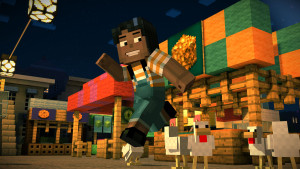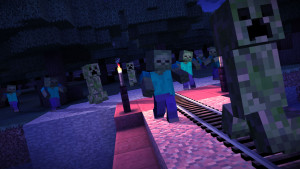Minecraft: Story Mode (PC, PS3, PS4, Xbox 360, Xbox One, iOS, Android)
![]() Minecraft: Story mode is a point-and-click videogame set in a phenomenally popular brand. If you haven’t had contact with a child under the age of 15, you may not know about the cultural phenomenon that is Minecraft. Minecraft is a very popular open-ended exploration and building game based around block-like graphics that give it a bit of a LEGO vibe. Minecraft: Story Mode is the first game that uses the Minecraft Universe as a setting. A cross between a point-and-click adventure and a quick-choice response system (think Dragon’s Lair in the arcade if you’re old enough), Minecraft Story Mode manages to deliver a fun, if simple, game that hits the spot for its target audience.
Minecraft: Story mode is a point-and-click videogame set in a phenomenally popular brand. If you haven’t had contact with a child under the age of 15, you may not know about the cultural phenomenon that is Minecraft. Minecraft is a very popular open-ended exploration and building game based around block-like graphics that give it a bit of a LEGO vibe. Minecraft: Story Mode is the first game that uses the Minecraft Universe as a setting. A cross between a point-and-click adventure and a quick-choice response system (think Dragon’s Lair in the arcade if you’re old enough), Minecraft Story Mode manages to deliver a fun, if simple, game that hits the spot for its target audience.
Using the standard blocky graphics of Minecraft, Story Mode tells the tale of four (or 5, depending on how you count) unlikely adventurers propelled into an epic tale where they must work together to survive and eventually save the world from a monster unleashed by the epic bad guy. The game plays through a series of dialogue choices, a point and click interface, and some time-limited keyboard commands (when told, press “up” quick enough in order to jump over an incoming attack.)
The dialogue choices offer three choices, with a default of silence if a player doesn’t select one with a time limit (pushing the story forward even if you are a very slow/poor reader.) Choices typically range from aggressive to polite/encouraging choices. In many, but not all, situations a message will appear onscreen indicating that particular character “will remember that.” This affects future interactions with that character.
At regular (but somewhat infrequent) intervals, the player is allowed to walk freely around an area, looking for additional items/information. The main points of interaction are easily located as a location target is displayed for most items of interest. Click on the target and the interaction occurs (explored, examined, avoided, etc…) Clicking on a person typically starts a conversation (presenting you with one or more sets of possible answers as the dialogue continues.)
The final interaction is a sort of action-y trigger based system. On the PC, players must quickly press the button displayed on the screen (nearly always a movement button from Q/W/E/A/S/D.) In some cases the player must press the button repeatedly to “power up” the particular action. This usually occurs when a character is trying to escape or overpower something. As a child of the 80’s this strongly reminded me of the old Laserdisc arcade game, Dragon’s Lair.
While the game provides regular choices, the entire story runs strongly on “rails” – meaning most things will happen anyway. However, the details of “how” things occur will sometimes differ (but you end up in more or less the same place.) This is understandable, since a game of this style can quickly balloon up into many branching trees. The effect is smooth, so younger gamers may not notice that the game continues onward along more or less the same route. This does limit replayability a bit but a run-through using a positive attitude will have a different vibe than a smarmy one. Some choices can kill off one’s character, but this only causes the game to reset to a state just prior to the poor (or too slow) choice.
That said, one interesting feature is the ability to compare one’s choices to others in the online community. Several choice points are saved and a menu displays how your choice matched or differed with the rest of the community. While most of the game is based on the interactions mentioned, there are a few puzzles scattered throughout the story. They tend to be rather easy, and while they take a bit of thinking they can often be eventually solved through semi-random button mashing.
The game is being released in five parts, with only the first part currently available. Most current modes of purchasing the game include all five parts, available for download as they are released.
Final Verdict:
Minecraft Story Mode nails it for the target audience of younger (elementary, possibly middle school) kids. It isn’t a deep game, but it captures the look and feel of the Minecraft universe. It reminds me of the well-done LEGO brand videogames, containing fun challenges along with a healthy dose of general humor as well as plenty of inside jokes for the Minecraft fan. While an older adult will not find the game challenging, they may still enjoy the lighthearted tale that progresses at a good clip. It is an easy recommendation for the younger set, even if they aren’t already a Minecraft fan.
Kid Factor:
No blood and guts here, although the big bad monster does look like an impressively scary monster (albeit one made of LEGOs.) While button mashing will most likely progress a player through the game, gamers who can read (for the responses) will feel more like they are a participant. Some of the clicking or timed-button pressing may be challenging for the youngest gamers, but if they’re moderately familiar with a mouse/keyboard or a gamepad (on the console versions) it shouldn’t be too much of a problem.







Discussion Area - Leave a Comment